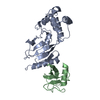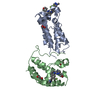+ Open data
Open data
- Basic information
Basic information
| Entry | Database: PDB / ID: 7myf | ||||||
|---|---|---|---|---|---|---|---|
| Title | Ubiquitin variant UbV.k.1 in complex with Ube2k | ||||||
 Components Components |
| ||||||
 Keywords Keywords | TRANSFERASE/INHIBITOR / Ubiquitin conjugating enzyme / degradation / ubiquitin variant / inhibitor / TRANSFERASE-INHIBITOR complex | ||||||
| Function / homology |  Function and homology information Function and homology informationfree ubiquitin chain polymerization / regulation of proteasomal ubiquitin-dependent protein catabolic process / filopodium tip / positive regulation of type I interferon-mediated signaling pathway / positive regulation of tumor necrosis factor-mediated signaling pathway / hypothalamus gonadotrophin-releasing hormone neuron development / female meiosis I / positive regulation of peptidyl-threonine phosphorylation / positive regulation of protein monoubiquitination / fat pad development ...free ubiquitin chain polymerization / regulation of proteasomal ubiquitin-dependent protein catabolic process / filopodium tip / positive regulation of type I interferon-mediated signaling pathway / positive regulation of tumor necrosis factor-mediated signaling pathway / hypothalamus gonadotrophin-releasing hormone neuron development / female meiosis I / positive regulation of peptidyl-threonine phosphorylation / positive regulation of protein monoubiquitination / fat pad development / mitochondrion transport along microtubule / ubiquitin-ubiquitin ligase activity / E2 ubiquitin-conjugating enzyme / female gonad development / seminiferous tubule development / male meiosis I / ubiquitin conjugating enzyme activity / positive regulation of intrinsic apoptotic signaling pathway by p53 class mediator / protein K48-linked ubiquitination / cellular response to interferon-beta / energy homeostasis / regulation of neuron apoptotic process / neuron projection morphogenesis / regulation of proteasomal protein catabolic process / Maturation of protein E / Maturation of protein E / ER Quality Control Compartment (ERQC) / Myoclonic epilepsy of Lafora / FLT3 signaling by CBL mutants / Prevention of phagosomal-lysosomal fusion / IRAK2 mediated activation of TAK1 complex / Alpha-protein kinase 1 signaling pathway / Glycogen synthesis / IRAK1 recruits IKK complex / IRAK1 recruits IKK complex upon TLR7/8 or 9 stimulation / Endosomal Sorting Complex Required For Transport (ESCRT) / Membrane binding and targetting of GAG proteins / Negative regulation of FLT3 / Regulation of TBK1, IKKε (IKBKE)-mediated activation of IRF3, IRF7 / PTK6 Regulates RTKs and Their Effectors AKT1 and DOK1 / Regulation of TBK1, IKKε-mediated activation of IRF3, IRF7 upon TLR3 ligation / Constitutive Signaling by NOTCH1 HD Domain Mutants / IRAK2 mediated activation of TAK1 complex upon TLR7/8 or 9 stimulation / NOTCH2 Activation and Transmission of Signal to the Nucleus / TICAM1,TRAF6-dependent induction of TAK1 complex / TICAM1-dependent activation of IRF3/IRF7 / APC/C:Cdc20 mediated degradation of Cyclin B / Downregulation of ERBB4 signaling / Regulation of FZD by ubiquitination / APC-Cdc20 mediated degradation of Nek2A / p75NTR recruits signalling complexes / InlA-mediated entry of Listeria monocytogenes into host cells / TRAF6 mediated IRF7 activation in TLR7/8 or 9 signaling / TRAF6-mediated induction of TAK1 complex within TLR4 complex / Regulation of pyruvate metabolism / NF-kB is activated and signals survival / Regulation of innate immune responses to cytosolic DNA / Downregulation of ERBB2:ERBB3 signaling / Pexophagy / NRIF signals cell death from the nucleus / VLDLR internalisation and degradation / Regulation of PTEN localization / Activated NOTCH1 Transmits Signal to the Nucleus / Synthesis of active ubiquitin: roles of E1 and E2 enzymes / Regulation of BACH1 activity / MAP3K8 (TPL2)-dependent MAPK1/3 activation / TICAM1, RIP1-mediated IKK complex recruitment / Translesion synthesis by REV1 / InlB-mediated entry of Listeria monocytogenes into host cell / Translesion synthesis by POLK / Activation of IRF3, IRF7 mediated by TBK1, IKKε (IKBKE) / Downregulation of TGF-beta receptor signaling / JNK (c-Jun kinases) phosphorylation and activation mediated by activated human TAK1 / Josephin domain DUBs / Translesion synthesis by POLI / IKK complex recruitment mediated by RIP1 / Regulation of activated PAK-2p34 by proteasome mediated degradation / Gap-filling DNA repair synthesis and ligation in GG-NER / positive regulation of protein ubiquitination / PINK1-PRKN Mediated Mitophagy / TGF-beta receptor signaling in EMT (epithelial to mesenchymal transition) / TNFR1-induced NF-kappa-B signaling pathway / Autodegradation of Cdh1 by Cdh1:APC/C / APC/C:Cdc20 mediated degradation of Securin / TCF dependent signaling in response to WNT / regulation of mitochondrial membrane potential / N-glycan trimming in the ER and Calnexin/Calreticulin cycle / Regulation of NF-kappa B signaling / Asymmetric localization of PCP proteins / activated TAK1 mediates p38 MAPK activation / Ubiquitin-dependent degradation of Cyclin D / SCF-beta-TrCP mediated degradation of Emi1 / NIK-->noncanonical NF-kB signaling / TNFR2 non-canonical NF-kB pathway / AUF1 (hnRNP D0) binds and destabilizes mRNA / Regulation of signaling by CBL / NOTCH3 Activation and Transmission of Signal to the Nucleus / Negative regulators of DDX58/IFIH1 signaling / Vpu mediated degradation of CD4 / Deactivation of the beta-catenin transactivating complex Similarity search - Function | ||||||
| Biological species |  Homo sapiens (human) Homo sapiens (human) | ||||||
| Method |  X-RAY DIFFRACTION / X-RAY DIFFRACTION /  SYNCHROTRON / SYNCHROTRON /  MOLECULAR REPLACEMENT / MOLECULAR REPLACEMENT /  molecular replacement / Resolution: 3 Å molecular replacement / Resolution: 3 Å | ||||||
 Authors Authors | Middleton, A.J. / Day, C.L. / Teyra, J. / Sidhu, S.S. | ||||||
| Funding support |  New Zealand, 1items New Zealand, 1items
| ||||||
 Citation Citation |  Journal: Acs Chem.Biol. / Year: 2021 Journal: Acs Chem.Biol. / Year: 2021Title: Identification of Ubiquitin Variants That Inhibit the E2 Ubiquitin Conjugating Enzyme, Ube2k. Authors: Middleton, A.J. / Teyra, J. / Zhu, J. / Sidhu, S.S. / Day, C.L. | ||||||
| History |
|
- Structure visualization
Structure visualization
| Structure viewer | Molecule:  Molmil Molmil Jmol/JSmol Jmol/JSmol |
|---|
- Downloads & links
Downloads & links
- Download
Download
| PDBx/mmCIF format |  7myf.cif.gz 7myf.cif.gz | 151.1 KB | Display |  PDBx/mmCIF format PDBx/mmCIF format |
|---|---|---|---|---|
| PDB format |  pdb7myf.ent.gz pdb7myf.ent.gz | 116.7 KB | Display |  PDB format PDB format |
| PDBx/mmJSON format |  7myf.json.gz 7myf.json.gz | Tree view |  PDBx/mmJSON format PDBx/mmJSON format | |
| Others |  Other downloads Other downloads |
-Validation report
| Summary document |  7myf_validation.pdf.gz 7myf_validation.pdf.gz | 448 KB | Display |  wwPDB validaton report wwPDB validaton report |
|---|---|---|---|---|
| Full document |  7myf_full_validation.pdf.gz 7myf_full_validation.pdf.gz | 452.2 KB | Display | |
| Data in XML |  7myf_validation.xml.gz 7myf_validation.xml.gz | 14 KB | Display | |
| Data in CIF |  7myf_validation.cif.gz 7myf_validation.cif.gz | 17.8 KB | Display | |
| Arichive directory |  https://data.pdbj.org/pub/pdb/validation_reports/my/7myf https://data.pdbj.org/pub/pdb/validation_reports/my/7myf ftp://data.pdbj.org/pub/pdb/validation_reports/my/7myf ftp://data.pdbj.org/pub/pdb/validation_reports/my/7myf | HTTPS FTP |
-Related structure data
| Related structure data |  7myhC  5dflS S: Starting model for refinement C: citing same article ( |
|---|---|
| Similar structure data |
- Links
Links
- Assembly
Assembly
| Deposited unit | 
| ||||||||
|---|---|---|---|---|---|---|---|---|---|
| 1 | 
| ||||||||
| 2 | 
| ||||||||
| Unit cell |
|
- Components
Components
| #1: Protein | Mass: 22555.721 Da / Num. of mol.: 1 / Mutation: C93K, K98R Source method: isolated from a genetically manipulated source Source: (gene. exp.)  Homo sapiens (human) / Gene: UBE2K, HIP2, LIG / Production host: Homo sapiens (human) / Gene: UBE2K, HIP2, LIG / Production host:  References: UniProt: P61086, E2 ubiquitin-conjugating enzyme |
|---|---|
| #2: Protein | Mass: 10681.906 Da / Num. of mol.: 1 Mutation: Q31F, G21R, T23Y, A57S, K59Q, K74E, E75F, T77F, V81I, L82S Source method: isolated from a genetically manipulated source Source: (gene. exp.)  Homo sapiens (human) / Gene: UBB / Production host: Homo sapiens (human) / Gene: UBB / Production host:  |
| #3: Protein | Mass: 8576.831 Da / Num. of mol.: 1 Source method: isolated from a genetically manipulated source Source: (gene. exp.)  Homo sapiens (human) / Gene: UBC / Production host: Homo sapiens (human) / Gene: UBC / Production host:  |
-Experimental details
-Experiment
| Experiment | Method:  X-RAY DIFFRACTION / Number of used crystals: 1 X-RAY DIFFRACTION / Number of used crystals: 1 |
|---|
- Sample preparation
Sample preparation
| Crystal | Density Matthews: 2.26505 Å3/Da / Density % sol: 49.5 % |
|---|---|
| Crystal grow | Temperature: 289 K / Method: vapor diffusion, sitting drop / Details: 0.2-0.3 M ammonium citrate dibasic, 20-25% PEG3350 |
-Data collection
| Diffraction | Mean temperature: 100 K / Serial crystal experiment: N | ||||||||||||||||||||||||||||||
|---|---|---|---|---|---|---|---|---|---|---|---|---|---|---|---|---|---|---|---|---|---|---|---|---|---|---|---|---|---|---|---|
| Diffraction source | Source:  SYNCHROTRON / Site: SYNCHROTRON / Site:  Australian Synchrotron Australian Synchrotron  / Beamline: MX2 / Wavelength: 0.9537 Å / Beamline: MX2 / Wavelength: 0.9537 Å | ||||||||||||||||||||||||||||||
| Detector | Type: DECTRIS EIGER2 X 16M / Detector: PIXEL / Date: Sep 26, 2019 | ||||||||||||||||||||||||||||||
| Radiation | Protocol: SINGLE WAVELENGTH / Monochromatic (M) / Laue (L): M / Scattering type: x-ray | ||||||||||||||||||||||||||||||
| Radiation wavelength | Wavelength: 0.9537 Å / Relative weight: 1 | ||||||||||||||||||||||||||||||
| Reflection | Resolution: 2.99→44.11 Å / Num. obs: 7820 / % possible obs: 96.3 % / Redundancy: 4.6 % / Biso Wilson estimate: 70.7 Å2 / CC1/2: 0.991 / Rmerge(I) obs: 0.17 / Rpim(I) all: 0.085 / Rrim(I) all: 0.191 / Net I/σ(I): 6.2 / Num. measured all: 36340 / Scaling rejects: 3 | ||||||||||||||||||||||||||||||
| Reflection shell | Diffraction-ID: 1
|
-Phasing
| Phasing | Method:  molecular replacement molecular replacement |
|---|
- Processing
Processing
| Software |
| ||||||||||||||||||||||||||||||||||||||||
|---|---|---|---|---|---|---|---|---|---|---|---|---|---|---|---|---|---|---|---|---|---|---|---|---|---|---|---|---|---|---|---|---|---|---|---|---|---|---|---|---|---|
| Refinement | Method to determine structure:  MOLECULAR REPLACEMENT MOLECULAR REPLACEMENTStarting model: PDB entry 5DFL Resolution: 3→37.892 Å / SU ML: 0.49 / Cross valid method: THROUGHOUT / σ(F): 1.35 / Phase error: 32.95 / Stereochemistry target values: ML
| ||||||||||||||||||||||||||||||||||||||||
| Solvent computation | Shrinkage radii: 0.9 Å / VDW probe radii: 1.11 Å / Solvent model: FLAT BULK SOLVENT MODEL | ||||||||||||||||||||||||||||||||||||||||
| Displacement parameters | Biso max: 137.71 Å2 / Biso mean: 75.9263 Å2 / Biso min: 38.89 Å2 | ||||||||||||||||||||||||||||||||||||||||
| Refinement step | Cycle: final / Resolution: 3→37.892 Å
| ||||||||||||||||||||||||||||||||||||||||
| LS refinement shell | Refine-ID: X-RAY DIFFRACTION / Rfactor Rfree error: 0
| ||||||||||||||||||||||||||||||||||||||||
| Refinement TLS params. | Method: refined / Origin x: -21.8745 Å / Origin y: -8.1613 Å / Origin z: -14.638 Å
| ||||||||||||||||||||||||||||||||||||||||
| Refinement TLS group |
|
 Movie
Movie Controller
Controller













 PDBj
PDBj

















